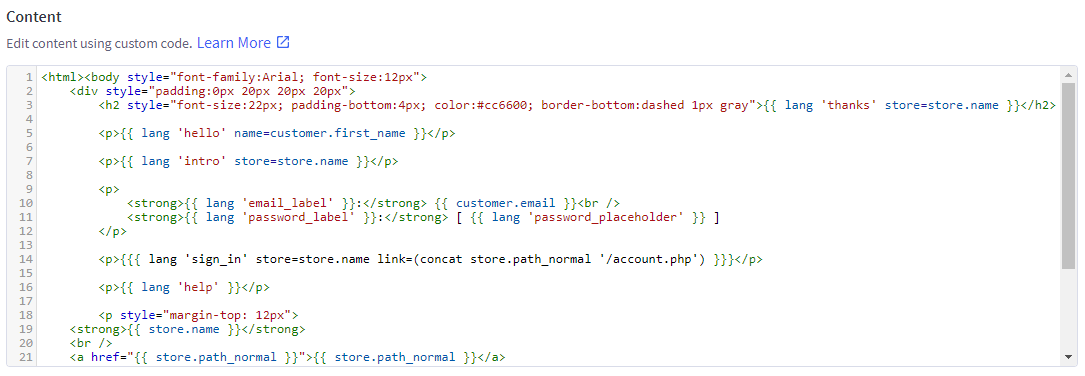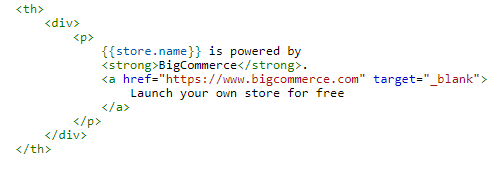- 03 Apr 2023
- 4 Minutes to read
- Print
- DarkLight
- PDF
Transactional Emails
- Updated on 03 Apr 2023
- 4 Minutes to read
- Print
- DarkLight
- PDF
You can customize and enable/disable store emails automatically sent to customers, like the order confirmation email. Customizing your email templates allows you to tailor your email messaging to fit your brand, adding to the customer experience. If you use a third party to manage customer emails, you may want to disable some or all of your store’s built-in emails.

Email Templates
The following email templates are available for editing:
- Abandoned Cart*
- Account Settings Edited
- Password Reset
- Order Status Update
- Order Email
- Guest Account Created
- Gift Certificate Recipient
- Sign-in Link Request
- Order Notification
- Product Review Request
- Return Requested
- Account Created
- Return Status Change
*The Content and settings for Abandoned Cart emails are managed in Marketing › Abandoned Cart Emails. The Abandoned Cart email template references any changes made to the Content and settings.
Managing Email Templates
Go to Marketing › Transactional Emails.
This page lists your store’s default global templates and a label showing whether they are currently enabled or disabled.

If you have more than one storefront, you can choose to have your storefront use your store’s default global templates and settings, or you can enable and customize templates individually per storefront.
Localized Store Experiences: This feature is available for all our supported languages.
Use the dropdown list at the top of the page to switch between managing global and individual storefront templates.

Click the ⋯ settings button next to a template, then select Edit Template from the dropdown to edit its phrases or code. You can also Disable or Enable a template from the dropdown.

To enable or disable a template while editing it, click the ⋯ settings button at the top of the page and select Enable or Disable.

Editing Template Phrases
Under the Phrases tab, you can customize the text used in the template. The Phrase name is an identifier used in the template code that outputs a string of text in the resulting email, called the Phrase value. The phrase name is not visible to the shopper.

You can change the Phrase name and Phrase value of existing phrases, or you can delete existing phrases by clicking the ⋯ settings button next to the phrase and selecting Delete phrase. You can create new phrases in a template by clicking the + Add new button at the bottom of the Phrases tab.

For example, you can add a phrase named "contact" to direct customers to contact you at a specific email address. In the phrase value, you can enter a phrase like "Contact us at info@mystore.com." It is also possible to add HTML in the phrase value if you want to create a clickable link like "<a href="mailto:info@mystore.com">info@mystore.com</a>."

Editing Template Code
Under the Code tab, the Subject line and Content of each template can be customized. The Subject has a maximum character limit of 255. Select variables are allowed, enabling you to show personalized information. Some variables can be used independently in a template, while others require additional formatting to show specific details. For example, the store name can be used separately, but listing the products in order requires different formatting.

Editing code? We recommend saving a backup copy of your template in a plain text editor such as Notepad or TextEdit. You can also restore the default version of an email's global template with the instructions below.
The template's body is customized by editing its underlying HTML and Handlebars code. It is divided between CSS styling at the top and HTML content at the bottom. We recommend making edits by copying the template code into a text editor and pasting the edited version into the Content box.

One example of what you can do in the Code tab is to remove the "Powered by BigCommerce" text at the bottom of an email and replace it with a phrase. To do this, locate the text in the code and delete it, leaving the paragraph tags. You can then add a phrase bracket in its place in the format of {{{ lang 'your_phrase_name' }}}.

Previewing Your Changes
Under the Preview tab, you can see a sample of the resulting email the template will produce. In the example of replacing the "Powered by BigCommerce" text with a phrase, you can see how the word will appear in the email and go back to the Phrases or Code tabs to make further changes if necessary.
Click Save when you’re done making changes.
You can also send a copy of a template’s resulting email to the inbox of your user account email address by clicking Send test email.

If you wish to restore the phrases and code in a global template to their original values, click the ⋯ settings button and select Reset to the system default.

To restore a storefront-specific template to global values, check the Use Global box.

Table of Global Variables
Below is a table of global variables that can be used in email templates.
| Variable | Corresponds to: | Output example |
|---|---|---|
| store. name | your store's name | "Thanks for Registering at My WineDirect Store" |
| store.domain_name | your store's domain name | "Your mywinedirectstore.com account details have changed" |
| store.logo.title | your store's logo text (used as the alt text for your logo image) | My WineDirect Store |
| store. Logo.url | your store's logo image URL | https://cdn11.winedirect.com/s-xyz123/product_images/storelogo.jpg |
| store.ssl_path | your stores HTTPS URL | "Your https://winedirect.com account details have changed" |
| store.cdn_path | your store's Content delivery network path URL | https://cdn11.winedirect.com/s-xyz123 |
| store.image_directory | the image directory URL tail in your store's CDN path | {{ store.cdn_path }}/{{ store.image_directory }} = https://cdn11.winedirect.com/s-xyz123/product_images |
| store.path_normal | , your store's HTTPS URL (used as a link at the bottom of some emails) | "My WineDIrect Store https://mywinedirectstore.com" |
| store.path | your store's HTTPS URL (used as a link in the logo and "go shopping" button) | https://mywinedirectstore.com |
| store.address | your store's physical address | "My WineDirect Store 110 Inner Campus Drive Austin, TX 78750 United States of America" |
| store.language.code | the language file used by your store's theme | If your theme is using en.json, then {{ store.language.code }} will be in |
| store.language.the direction | that the text in your store is read | If the text in your store is read left-to-right, then {{ store.language.directory }} will be ltr |
| customer.first_name | The customer's first name | "Hello, John," |
| customer.full_name | The customer's full name | "Hello, John Smith," |
| customer.email | The customer's email address | "Email Address: john.s@example.com" |
| misc.year | The current year | "© 2021 My WineDierct Store |


